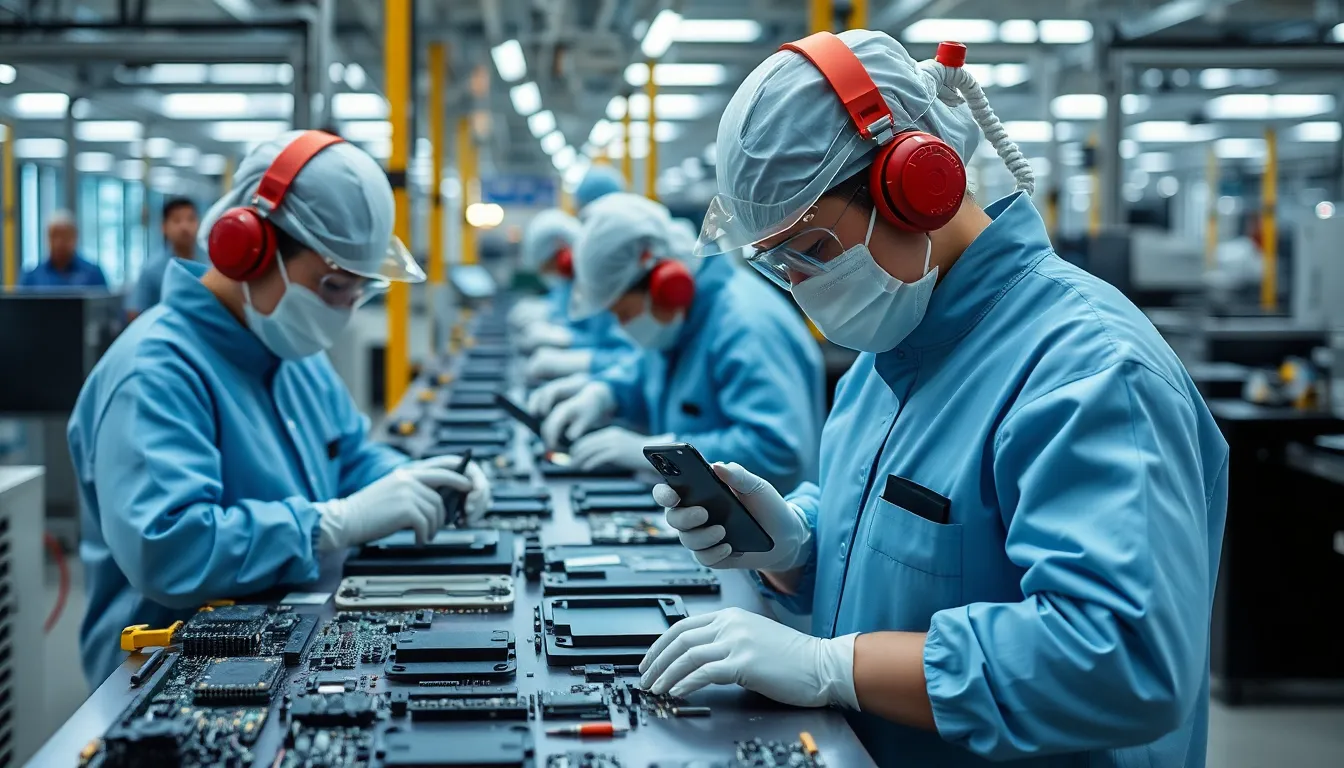When it comes to the iPhone 15, one question keeps buzzing in everyone’s mind: where’s this sleek piece of tech wizardry actually made? Is it conjured up in a secret underground lab? Or perhaps crafted by tiny elves in a mystical forest? Spoiler alert: it’s a bit more mundane, yet fascinating!
Table of Contents
ToggleOverview Of The iPhone 15
The iPhone 15 showcases advanced technology and innovation. Apple designs this smartphone to enhance user experience with features like improved battery life and upgraded cameras. With its sleek design, the iPhone 15 attracts attention in the competitive smartphone market.
High-quality materials comprise the build of the iPhone 15. Stainless steel and glass contribute to its premium feel, ensuring durability and aesthetics. The display, featuring Super Retina XDR technology, provides vivid colors and sharp details, enriching media consumption.
Performance stands out thanks to the latest A16 Bionic chip. This chip includes a six-core CPU and five-core GPU, delivering fast processing and graphics capabilities. The enhanced efficiency contributes to longer battery life, allowing more use on a single charge.
Camera technology excels with the iPhone 15. The dual-camera system includes improved sensors and computational photography enhancements. Users enjoy features like Night mode and Deep Fusion for stunning photos in various lighting conditions.
Connectivity options further enhance the iPhone 15’s functionality. Support for 5G technology enables blazing-fast download and streaming speeds. Wireless capabilities like Bluetooth 5.3 provide seamless connections to other devices.
Apple’s commitment to privacy and security stands firm in the iPhone 15. Features like Face ID and end-to-end encryption ensure user data remains secure. With regular software updates, users benefit from the latest security enhancements.
Sustainability practices reflect in the manufacturing process of the iPhone 15. Apple’s focus on using recycled materials and minimizing carbon footprints demonstrates dedication to environmental responsibility. Each new model represents a step towards a greener future in tech.
Manufacturing Locations

The iPhone 15’s manufacturing includes various countries renowned for their advanced technology and skilled labor.
Primary Production Countries
China serves as the primary production hub for Apple, hosting key facilities that assemble most iPhone components. Japan also plays a critical role, producing high-quality parts like displays and chips. South Korea contributes significantly with semiconductor manufacturing, essential for the device’s performance. Additionally, the United States engages in design and research, with some components sourced domestically. Individual components come from multiple suppliers across the globe, ensuring a comprehensive production network for the iPhone 15.
Minor Assembly Sites
Beyond larger manufacturing centers, a few minor assembly sites assist in the iPhone 15’s creation. Countries like India are gradually increasing their role in assembly, reflecting Apple’s strategy to diversify production. Brazil facilitates local assembly to better serve Latin American markets, while Vietnam is emerging as a significant player in the electronics sector, hosting some assembly operations. These locations help to streamline production and distribution, improving overall efficiency and responsiveness to market demands.
Materials Used In The iPhone 15
The iPhone 15 incorporates a diverse range of materials that contribute to its performance and design.
Sourcing Of Raw Materials
Apple sources raw materials from various locations worldwide. Lithium for batteries primarily comes from Australia and Chile. Cobalt, critical for battery production, is largely extracted in the Democratic Republic of Congo. Furthermore, rare earth elements, essential for components like displays and cameras, are often sourced from China. These materials play a significant role in enhancing device functionality and longevity, ensuring users experience advanced technology in their hands.
Sustainability Considerations
Sustainability remains a priority for Apple during the production of the iPhone 15. The company utilizes recycled aluminum and rare earth materials in its manufacturing processes. By integrating recycled components, Apple aims to reduce its environmental impact. Moreover, suppliers are encouraged to adopt eco-friendly practices to minimize carbon emissions. Through these initiatives, Apple demonstrates its commitment to environmental responsibility while maintaining high-quality standards in its products.
Labor Conditions In Manufacturing
Labor conditions in iPhone 15 manufacturing represent a significant aspect of Apple’s operations. Transparency about workforce practices remains crucial for the company.
Workforce Insights
Foxconn and Pegatron, two major assemblers, employ hundreds of thousands of workers in China. Workers often face long hours and demanding targets. Research highlights that approximately 20 percent of these workers live in dormitories, with limited access to personal space. Employment practices vary widely, with some workers reporting satisfaction due to fair wages, while others express concerns regarding working conditions. Initiatives promoting skills training and career growth enhance worker prospects within these facilities.
Fair Labor Practices
Apple actively engages with suppliers to ensure compliance with fair labor practices. The company conducts regular audits, addressing issues such as worker treatment, wages, and safety standards. In 2021, Apple reported a focus on increasing wages and improving working conditions for workers in its supply chain. Many suppliers committed to upholding employees’ rights, creating a more equitable work environment. By partnering with organizations like the Fair Labor Association, Apple seeks to promote ethical labor standards across its manufacturing landscape.
The iPhone 15 represents a remarkable blend of technology and design crafted across multiple countries. While China remains the primary manufacturing hub, contributions from Japan and South Korea enhance its quality and performance. Apple’s commitment to sustainability and ethical labor practices underscores its dedication to responsible manufacturing.
As users enjoy the innovative features and capabilities of the iPhone 15, they can also appreciate the complex global network that brings this device to life. With a focus on enhancing user experience while prioritizing environmental responsibility, Apple continues to set a standard in the tech industry.




